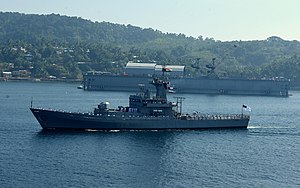
The Falkland Islands are a British overseas territory and, as such, rely on the United Kingdom for the guarantee of their security. The other UK territories in the South Atlantic, South Georgia and the South Sandwich Islands, fall under the protection of British Forces South Atlantic Islands (BFSAI), formerly known as British Forces Falkland Islands (BFFI), which includes commitments from the British Army, Royal Air Force and Royal Navy. They are headed by the Commander, British Forces South Atlantic Islands (CBFSAI), a brigadier-equivalent appointment that rotates among all three services.
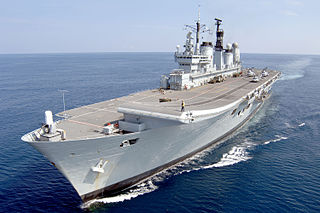
The Invincible class was a class of light aircraft carrier operated by the Royal Navy. Three ships were constructed: HMS Invincible, HMS Illustrious and HMS Ark Royal. The vessels were built as aviation-capable anti-submarine warfare (ASW) platforms to counter the Cold War North Atlantic Soviet submarine threat, and initially embarked Sea Harrier aircraft and Sea King HAS.1 anti-submarine helicopters. With cancellation of the aircraft carriers renewal programme in the 1960s, the three ships became the replacements for Ark Royal and Eagle fleet carriers and the Centaur-class light fleet carriers, and the Royal Navy's sole class of aircraft carrier.
This is a list of the naval forces from the United Kingdom that took part in the Falklands War, often referred to as "the Task Force" in the context of the war. For a list of naval forces from Argentina, see Argentine naval forces in the Falklands War.

The Exocet is a French-built anti-ship missile whose various versions can be launched from surface vessels, submarines, helicopters and fixed-wing aircraft.

A patrol boat is a relatively small naval vessel generally designed for coastal defence, border security, or law enforcement. There are many designs for patrol boats, and they generally range in size. They may be operated by a nation's navy, coast guard, police, or customs, and may be intended for marine, estuarine, or river environments.
HMS Leeds Castle (P258) was a Castle-class patrol vessel built by Hall, Russell & Company of Aberdeen, Scotland for the Royal Navy. She was launched in October 1980 and commissioned the following August. She was involved in the 1982 Falklands War, operating between the British territories of Ascension Island, South Georgia, and the Falkland Islands as a dispatch vessel commanded by Lieutenant-Commander Colin Hamilton.
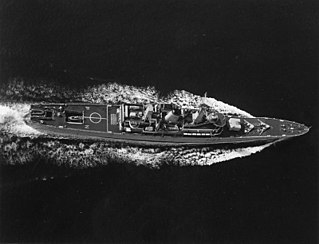
HMS Penelope was a Leander-class frigate of the Royal Navy. In the Falklands War, Penelope fired on an Argentine patrol boat and claimed to be the last ship attacked by Argentine aircraft over the course of the war. In 1991, she was commissioned into the Ecuadorean Navy, and renamed Presidente Eloy Alfaro.
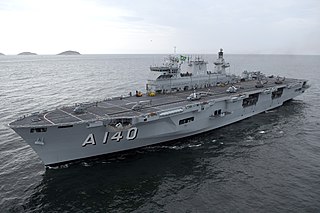
Landing platform helicopter (LPH) is a term used by some navies to denote a type of amphibious warfare ship designed primarily to operate as a launch and recovery platform for helicopters and other VTOL aircraft. As such, they are considered a type of helicopter carrier.

The Island-class patrol vessel was first designed and built for the Scottish Fisheries Protection Agency. As a result of the Royal Navy's experiences in the Cod Wars with Iceland, FPV Jura and FPV Westra were put in fishery protection patrols, the Navy built a further seven. These ships were designed and built by Hall Russell of Aberdeen, Scotland.

The River class is a class of offshore patrol vessels built primarily for the Royal Navy of the United Kingdom. A total of nine were built for the Royal Navy (RN), four Batch 1 and five Batch 2. One Batch 1 (HMS Clyde), which was the Falklands guard ship, was decommissioned and transferred at the end of its lease to the Royal Bahrain Naval Force.

Standing Royal Navy deployments is a list of operations and commitments undertaken by the United Kingdom's Royal Navy on a worldwide basis. The following list details these commitments and deployments sorted by region and in alphabetical order. Routine deployments made by the Navy's nuclear-powered submarines and their location of operations is classified.

HMS Dumbarton Castle (P265) was an offshore patrol vessel of the British Royal Navy. Her main role was the protection of the offshore assets of the United Kingdom, including oil and gas installations and fisheries out to the 200-nautical-mile limit.

An anti-submarine warfare carrier is a type of small aircraft carrier whose primary role is as the nucleus of an anti-submarine warfare hunter-killer group. This type of ship came into existence during the Cold War as a development of the escort carriers used in the ASW role in the North Atlantic during World War II.

The Iraqi Naval Forces, or the Iraqi Navy, is the naval warfare service branch of the Armed forces of Iraq. Formed in 1937, initially as the Iraqi Coastal Defense Force, its primary responsibilities was the protection of Iraq's coastline and offshore assets, the official name was changed on 12 January 2005 to Iraqi Naval Forces

HMS Clyde was an offshore patrol vessel and was the tenth Royal Navy vessel to carry the name. She was launched on 14 June 2006 in Portsmouth Naval Base by VT Group shipbuilders in Portsmouth and is the fourth vessel of the River class, with a displacement of 2,000 tonnes and a 30 mm Oerlikon KCB gun in place of the 20 mm gun fitted to Tyne River-class ships. Clyde was decommissioned on the 20 December 2019 at HMNB Portsmouth and was returned to her owners at BAE Systems Maritime - Naval Ships, although the ship remained under lease from BAE Systems to the Royal Navy until the end of March 2020. In August 2020 Clyde was transferred to the Kingdom of Bahrain.
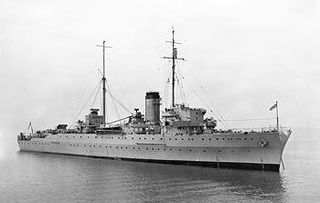
HMS Protector was an Antarctic patrol vessel of the Royal Navy between 1955 and 1968. She was built in 1935 as a net laying ship.

BNS Turag is an Island-class offshore patrol vessel of the Bangladesh Navy. She has been serving in the Bangladesh Navy since 2004.

BNS Gomati is an Island-class offshore patrol vessel of the Bangladesh Navy. She was originally built as a Fishery Protection Vessel for the British Royal Navy, entering service as HMS Anglesey in 1979. She was sold to Bangladesh in 2002, entering service in 2003.

HMS Forth is a Batch 2 River-class offshore patrol vessel in active service with the Royal Navy. Named after the River Forth, she is the first Batch 2 River-class vessel to be built. She was commissioned into the Royal Navy on 13 April 2018, following a commissioning ceremony at her homeport HMNB Portsmouth. In January 2020 she replaced HMS Clyde as the Falkland Islands patrol ship.

MS Europic Ferry was a roll-on/roll-off car ferry built in 1967 by Swan Hunter for the Atlantic Steam Navigation Company (ASN). She was acquired by European Ferries in 1971 when they took over the ASN and served with them under the Townsend Thoresen branding. The Europic Ferry was requisitioned by the British government in April 1982 and transported stores, equipment and troops to the South Atlantic during the Falklands War. After the war she returned to service with European Ferries until that company was sold to P&O in 1987. She was sold again to Namora Shipping in 1993 and served on routes in the Mediterranean until sold for scrapping in 2004.
